7.4: Tang Dynasty (618 CE – 906 CE)
- Page ID
- 219995
\( \newcommand{\vecs}[1]{\overset { \scriptstyle \rightharpoonup} {\mathbf{#1}} } \)
\( \newcommand{\vecd}[1]{\overset{-\!-\!\rightharpoonup}{\vphantom{a}\smash {#1}}} \)
\( \newcommand{\id}{\mathrm{id}}\) \( \newcommand{\Span}{\mathrm{span}}\)
( \newcommand{\kernel}{\mathrm{null}\,}\) \( \newcommand{\range}{\mathrm{range}\,}\)
\( \newcommand{\RealPart}{\mathrm{Re}}\) \( \newcommand{\ImaginaryPart}{\mathrm{Im}}\)
\( \newcommand{\Argument}{\mathrm{Arg}}\) \( \newcommand{\norm}[1]{\| #1 \|}\)
\( \newcommand{\inner}[2]{\langle #1, #2 \rangle}\)
\( \newcommand{\Span}{\mathrm{span}}\)
\( \newcommand{\id}{\mathrm{id}}\)
\( \newcommand{\Span}{\mathrm{span}}\)
\( \newcommand{\kernel}{\mathrm{null}\,}\)
\( \newcommand{\range}{\mathrm{range}\,}\)
\( \newcommand{\RealPart}{\mathrm{Re}}\)
\( \newcommand{\ImaginaryPart}{\mathrm{Im}}\)
\( \newcommand{\Argument}{\mathrm{Arg}}\)
\( \newcommand{\norm}[1]{\| #1 \|}\)
\( \newcommand{\inner}[2]{\langle #1, #2 \rangle}\)
\( \newcommand{\Span}{\mathrm{span}}\) \( \newcommand{\AA}{\unicode[.8,0]{x212B}}\)
\( \newcommand{\vectorA}[1]{\vec{#1}} % arrow\)
\( \newcommand{\vectorAt}[1]{\vec{\text{#1}}} % arrow\)
\( \newcommand{\vectorB}[1]{\overset { \scriptstyle \rightharpoonup} {\mathbf{#1}} } \)
\( \newcommand{\vectorC}[1]{\textbf{#1}} \)
\( \newcommand{\vectorD}[1]{\overrightarrow{#1}} \)
\( \newcommand{\vectorDt}[1]{\overrightarrow{\text{#1}}} \)
\( \newcommand{\vectE}[1]{\overset{-\!-\!\rightharpoonup}{\vphantom{a}\smash{\mathbf {#1}}}} \)
\( \newcommand{\vecs}[1]{\overset { \scriptstyle \rightharpoonup} {\mathbf{#1}} } \)
\( \newcommand{\vecd}[1]{\overset{-\!-\!\rightharpoonup}{\vphantom{a}\smash {#1}}} \)
\(\newcommand{\avec}{\mathbf a}\) \(\newcommand{\bvec}{\mathbf b}\) \(\newcommand{\cvec}{\mathbf c}\) \(\newcommand{\dvec}{\mathbf d}\) \(\newcommand{\dtil}{\widetilde{\mathbf d}}\) \(\newcommand{\evec}{\mathbf e}\) \(\newcommand{\fvec}{\mathbf f}\) \(\newcommand{\nvec}{\mathbf n}\) \(\newcommand{\pvec}{\mathbf p}\) \(\newcommand{\qvec}{\mathbf q}\) \(\newcommand{\svec}{\mathbf s}\) \(\newcommand{\tvec}{\mathbf t}\) \(\newcommand{\uvec}{\mathbf u}\) \(\newcommand{\vvec}{\mathbf v}\) \(\newcommand{\wvec}{\mathbf w}\) \(\newcommand{\xvec}{\mathbf x}\) \(\newcommand{\yvec}{\mathbf y}\) \(\newcommand{\zvec}{\mathbf z}\) \(\newcommand{\rvec}{\mathbf r}\) \(\newcommand{\mvec}{\mathbf m}\) \(\newcommand{\zerovec}{\mathbf 0}\) \(\newcommand{\onevec}{\mathbf 1}\) \(\newcommand{\real}{\mathbb R}\) \(\newcommand{\twovec}[2]{\left[\begin{array}{r}#1 \\ #2 \end{array}\right]}\) \(\newcommand{\ctwovec}[2]{\left[\begin{array}{c}#1 \\ #2 \end{array}\right]}\) \(\newcommand{\threevec}[3]{\left[\begin{array}{r}#1 \\ #2 \\ #3 \end{array}\right]}\) \(\newcommand{\cthreevec}[3]{\left[\begin{array}{c}#1 \\ #2 \\ #3 \end{array}\right]}\) \(\newcommand{\fourvec}[4]{\left[\begin{array}{r}#1 \\ #2 \\ #3 \\ #4 \end{array}\right]}\) \(\newcommand{\cfourvec}[4]{\left[\begin{array}{c}#1 \\ #2 \\ #3 \\ #4 \end{array}\right]}\) \(\newcommand{\fivevec}[5]{\left[\begin{array}{r}#1 \\ #2 \\ #3 \\ #4 \\ #5 \\ \end{array}\right]}\) \(\newcommand{\cfivevec}[5]{\left[\begin{array}{c}#1 \\ #2 \\ #3 \\ #4 \\ #5 \\ \end{array}\right]}\) \(\newcommand{\mattwo}[4]{\left[\begin{array}{rr}#1 \amp #2 \\ #3 \amp #4 \\ \end{array}\right]}\) \(\newcommand{\laspan}[1]{\text{Span}\{#1\}}\) \(\newcommand{\bcal}{\cal B}\) \(\newcommand{\ccal}{\cal C}\) \(\newcommand{\scal}{\cal S}\) \(\newcommand{\wcal}{\cal W}\) \(\newcommand{\ecal}{\cal E}\) \(\newcommand{\coords}[2]{\left\{#1\right\}_{#2}}\) \(\newcommand{\gray}[1]{\color{gray}{#1}}\) \(\newcommand{\lgray}[1]{\color{lightgray}{#1}}\) \(\newcommand{\rank}{\operatorname{rank}}\) \(\newcommand{\row}{\text{Row}}\) \(\newcommand{\col}{\text{Col}}\) \(\renewcommand{\row}{\text{Row}}\) \(\newcommand{\nul}{\text{Nul}}\) \(\newcommand{\var}{\text{Var}}\) \(\newcommand{\corr}{\text{corr}}\) \(\newcommand{\len}[1]{\left|#1\right|}\) \(\newcommand{\bbar}{\overline{\bvec}}\) \(\newcommand{\bhat}{\widehat{\bvec}}\) \(\newcommand{\bperp}{\bvec^\perp}\) \(\newcommand{\xhat}{\widehat{\xvec}}\) \(\newcommand{\vhat}{\widehat{\vvec}}\) \(\newcommand{\uhat}{\widehat{\uvec}}\) \(\newcommand{\what}{\widehat{\wvec}}\) \(\newcommand{\Sighat}{\widehat{\Sigma}}\) \(\newcommand{\lt}{<}\) \(\newcommand{\gt}{>}\) \(\newcommand{\amp}{&}\) \(\definecolor{fillinmathshade}{gray}{0.9}\)Introduction
The Tang dynasty (7.4.1) was in power from 618 to 907 and developed into a time historians consider the high point of Chinese history. The dynasty's military conquests were extensive, and the dynasty developed into a very cosmopolitan culture. At one point, almost 50 million people lived within the dynasty's borders, with Chang'an as the capital.[1] Creativity flourished, and prosperity grew based on robust trade from the Silk Road and the stimulus from foreign traders and other unique cultures. The Tibetans closed the Silk Road from China when they were in control; however, under the Tang, the road reopened, and the trade flow continued.
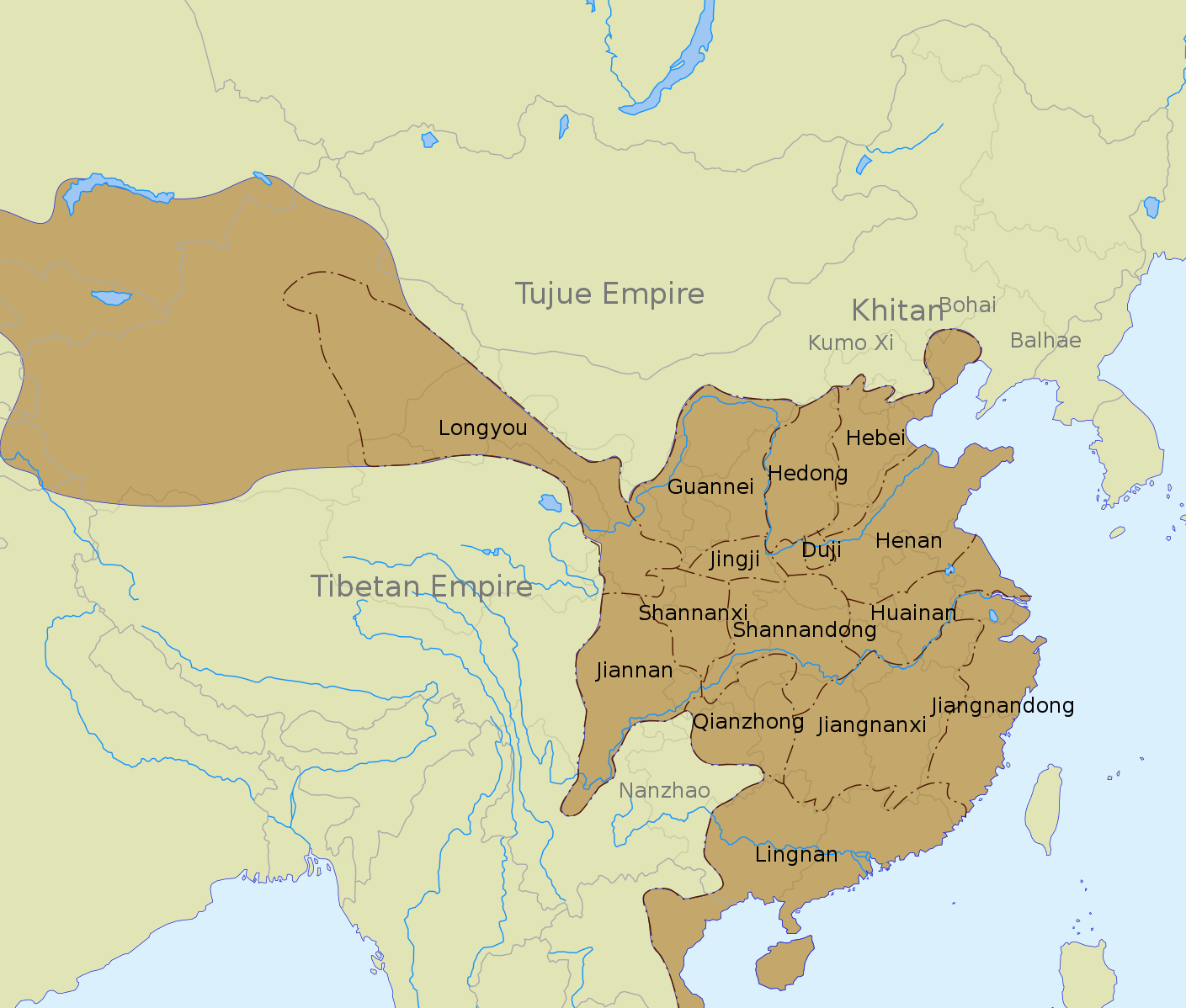
The Tang developed new legal codes for how to govern, the definition of crimes and punishments providing a new blueprint for future governments. The government became centralized and with local controls defined. The emperor was in control, especially of the military. Previously, military troops were conscripted for a specific battle and then returned home. Under the Tang, the military became a permanent army with continually assigned troops. The dynasty also changed the government employees and hired people with scholastic skills instead of those of wealth and status. Educated candidates were qualified, and a staff of career officials was created. Daoists and Buddhists were allowed into the court, and the supporting monasteries and abbey expanded their wealth and influence.
Significant technological inventions occurred during the Tang dynasty, including new methods of timekeeping and woodblock printing for books – the dominant process until the 11th century. Maps were drawn to scale with grid lines; waterproof varnish was invented, as well as translucent porcelain and even ordinary toilet paper. Tea was also an essential drink for people; however, during the Tang period, tea and tea ceremonies became an art form, and they even invented the idea of a sewn folded bag to hold loose tea.
Chang'an
Previous dynasties used Chang'an (7.4.2) as the capital, a town continually attacked and destroyed by wars. The Tang dynasty also used the city as the capital, modernizing it as they rebuilt it. After surrounding the city with walls, the palace was built at the northern end of the grand and broad avenue, running from one side straight to the palace. The streets were formed into parallel lines, much like a checkerboard. Important buildings were constructed inside the massive city walls, including temples and monasteries, homes for the elite and ruling class, and markets and gardens. The city became a center for trade, and people of all cultures came, making it known for its diverse ethnic population and distinct religions. The population of the city and surrounding countryside reached two million inhabitants, the largest city in the world.[2]
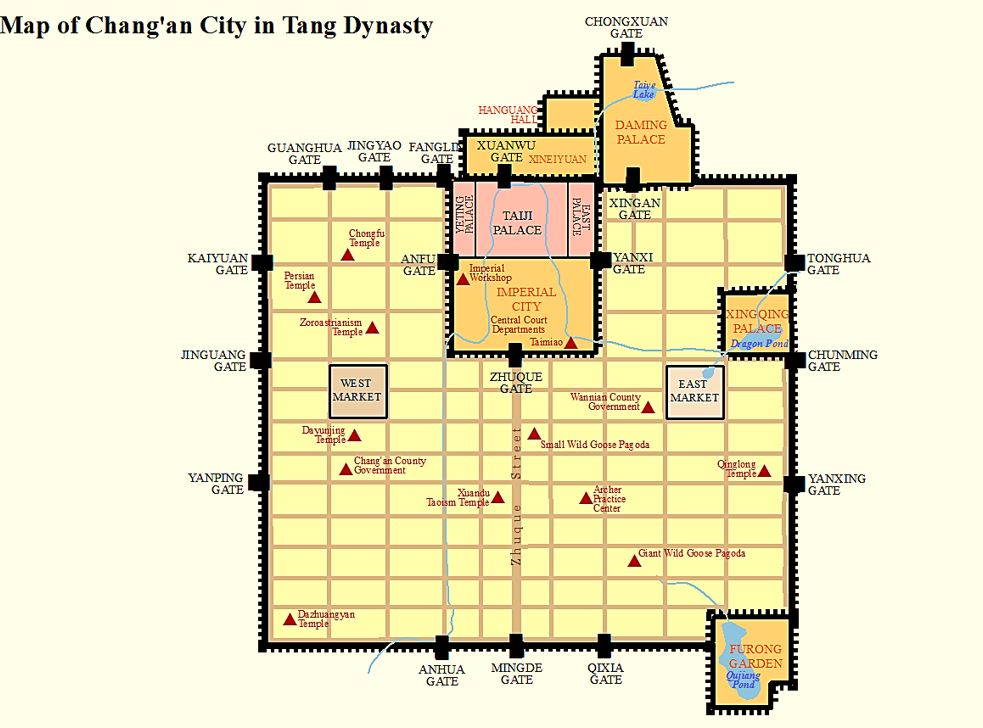
Qianling Mausoleum
The Qianling Mausoleum was constructed eighty kilometers from the capital city of Chang'an and was the tomb of Emperor Gaozong and Empress Wu Zetian. The emperor and empress shared a tomb, an unusual occurrence. As the only female ruler in China, the empress had equal status to her husband and common burial rites. One hundred twenty-four sizable stone human figures (7.4.3) stood along the avenue leading to the tomb. The figures symbolized the king's bodyguards wearing long robes with helmets. Other statues included different animals, including a winged horse (7.4.4). One part of the grounds contained sixty-one life-sized statues (7.4.5) that characterized foreign representatives attending the funeral. Each statue was etched with the person's name and country. The empress also had a stone stele (7.4.6) standing 6.3 meters.
The stele was blank without any writing. Her will stated: "My achievements and errors must be evaluated by later generations; therefore, carve no characters on my stele."[3]
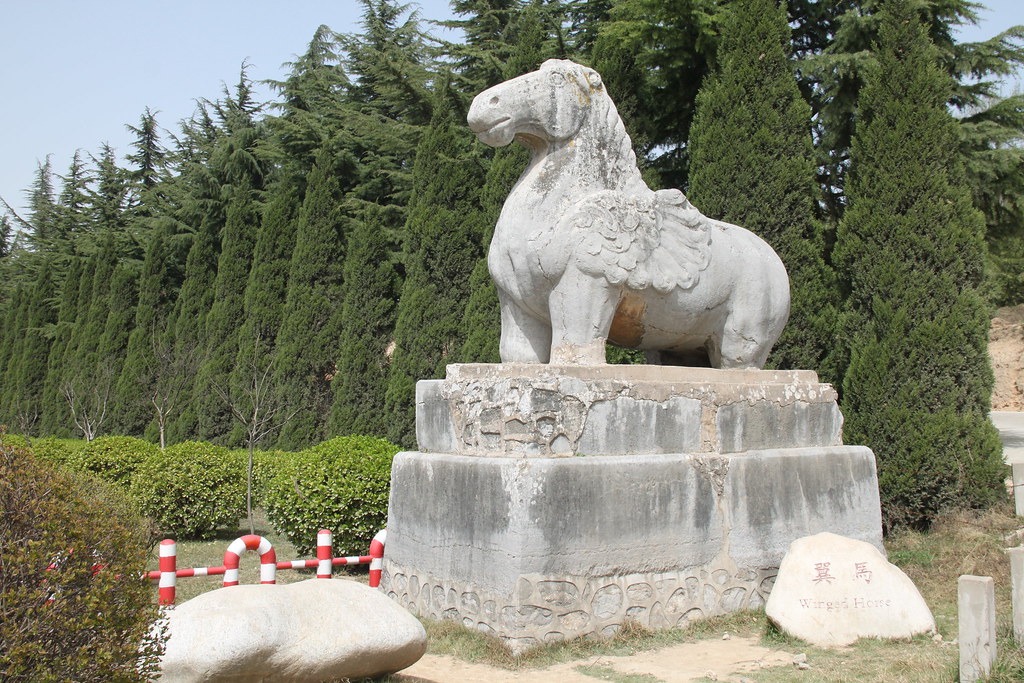

Simpler tombs for relatives and attendants were constructed at the site with entrances, hallways, and chambers. Unfortunately, the tombs were looted over the centuries; however, the detailed murals on the walls were untouched and represented the Tang dynasty's painting style. The Court Ladies (7.4.7) figures were painted and outlined in black. The Tang court women are dressed in typical long robes, each with a unique pattern. Even the arrangement of their hair is different for each person. Slight hints of red were used to accent places in the portrait. Although the woman in the center is behind the others, she becomes the center point when the other women are slightly apart. The foreign ambassadors (7.4.8) are painted as they would be seen waiting to be received at court as the representative of their country. The two figures on the right are from Korea and wear their best clothing in Korean style. The man with a large nose in the center is from a Western country. He wears rather plain clothing and does not have the elegant headdress worn by representatives from other Asian countries.
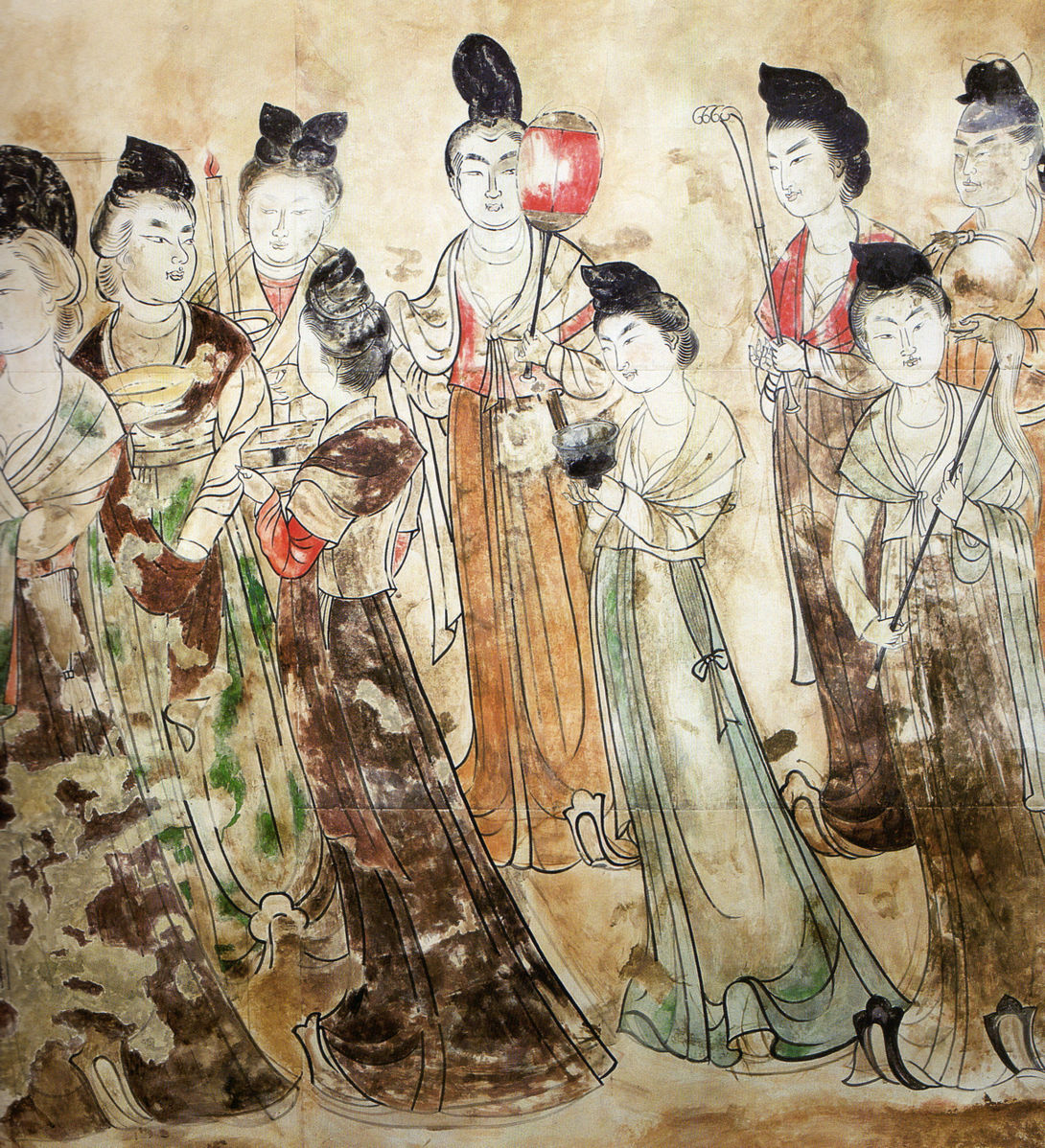

Longmen Grottoes
The Longmen Grottoes (7.4.9) were found in Henan Province. Carved in a kilometer of limestone cliffs are over 2,300 caves and niches containing 110,000 Buddhist stone statues, over 60 stupas, and 2,800 carved inscriptions. Work on the caves started in the 5th century and continued for 150 years, each of the sculptures performed by different artists, reflecting the styles of many artisans working on the immense project.[4] There are cliffs on both sides of the river. The caves along the eastern bank (7.4.10) housed the monks and the caves on the western side had the more elaborate carvings. All the caves were different sizes and ranged from small etched caves to more extensive caves made to walk in. For the large caves, figures were carved into the walls and ceilings. Initially, the statues were painted bright blue, red, and ochre; however, only hints of paint remain on those found in protected caves.
During the Tang dynasty, Buddhism incorporated international types of belief, and monks traveled from multiple Asian countries to the Longmen Grotto. Emperor Gaozong and Empress Wu commissioned the Fengxian Temple (Ancestor Worshipping Cave) containing the largest Buddha statue. The Vairocana Buddha (7.4.11) is seventeen meters high with a bodhisattva, Vajrapani (thunderbolt holder), and king on either side of the Buddha. Vairocana represents the primordial Buddha who generates and presides over all the Buddhas of the infinite universes that form Buddhist cosmology. This idea—of the power of one supreme deity over all the others—resonated in the vast Tang Empire, which was dominated by the emperor at its summit and supported by his subordinate officials. These monumental sculptures intentionally mirrored the political situation. [5] The massive Buddha was in the back of the cave, and his oversized ears were two meters long. The statues in the cave were protected and had minor damage, so even the names of the sculptors who carved the rock are visible.
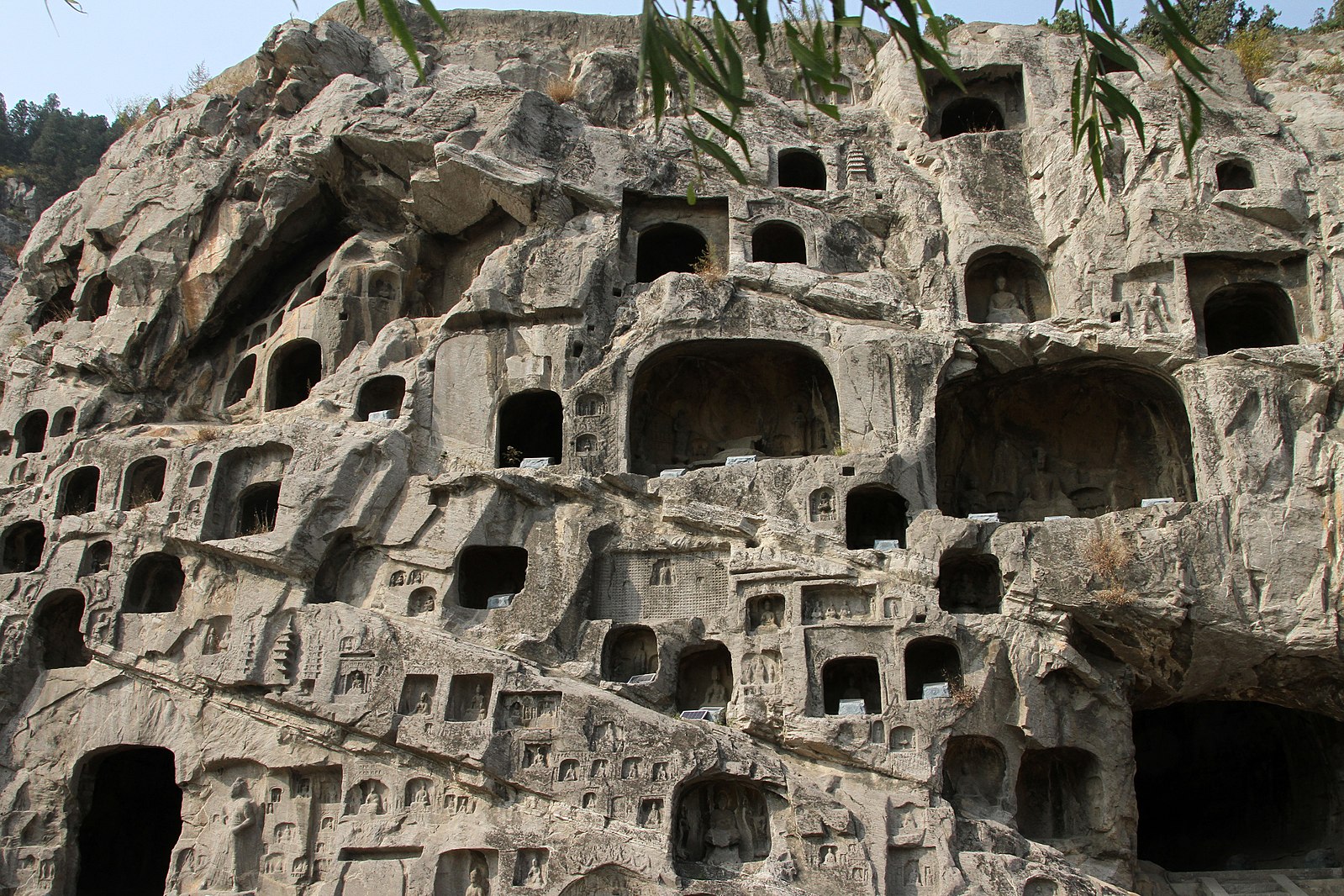 Figure \(\PageIndex{10}\): Longmen Grottoes (Gerd Eichmann, CC BY-SA 4.0)
Figure \(\PageIndex{10}\): Longmen Grottoes (Gerd Eichmann, CC BY-SA 4.0)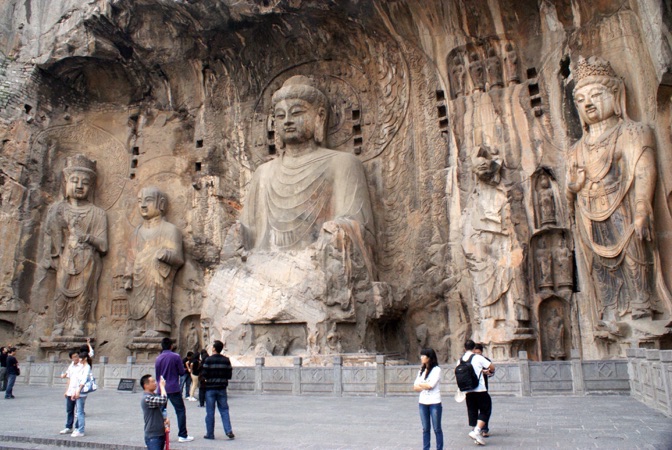 Figure \(\PageIndex{11}\): Vairocana Buddha (Sanjay P. K., CC BY-NC-ND 2.0)
Figure \(\PageIndex{11}\): Vairocana Buddha (Sanjay P. K., CC BY-NC-ND 2.0)Explore ancient Buddhist cave shrines in China and discover why the sites were created. Among the familiar landmarks of early Buddhist art in China are the cave shrines at Dunhuang, Yungang, and Longmen. Why were these sites created? Who were the major sponsors and patrons? Dunhuang was located along the Silk Roads at the far western edge of China. Merchants, local rulers, landowners, and travelers supported the local monastic community by excavating hundreds of caves along the nearby cliffs over a period of a thousand years.
Pagodas
Throughout the Tang dynasty, multiple pagodas were constructed, including the Giant Wild Goose Pagoda (7.4.12). The pagoda was built in 652 with five stories made with rammed earth covered with a stone façade. The pagoda commemorated the temple's famous abbot, Xuanzang, who had traveled the Silk Road and India and brought hundreds of Buddhist texts (sutras) back to China. The pagoda was built to hold the sutras and Buddha figurines. The stone façade on the building collapsed, and in 704, the empress had five more stories added to the pagoda, and the façade was rebuilt. An earthquake in 1556 again damaged the building and reduced it to the seven-story, sixty-four-meter-high building seen today. The pagoda is in the center of Da Ci'en Temple
Constructed in 636, the Xumi Pagoda (7.4.13), also known as the Summer Pagoda, was part of a Buddhist monastery. The brick pagoda was built on a stone base, has a height of forty-eight meters, and was based on the design of the Giant Wild Goose Pagoda. The monastery was destroyed; however, the pagoda remains in good condition. The pagoda has nine levels of eaves, a prominent spire on the top, and artistic stone carvings on the base. Inside, the pagoda is hollow and does not have any stairs. Near the doorway of the pagoda is the stone bixi, a mythical animal shaped like a combination of a turtle and dragon.
The unusual Nine Pinnacle Pagoda (7.4.14) was built between 742 and 756 in an octagon shape instead of the ordinary four-sided pagoda construction. The pagoda was constructed with bricks tightly laid without mortar. Although the building forms an equilateral octagon, the walls curve inwards. Inside, the pagoda is only one story. The pagoda's roof is the most unusual part of the building, with nine short, small objects shaped like pagodas (7.4.15). Each little pagoda is formed with three eave-stories and a minute door. Eight of the pagodas are fashioned above the eight walls of the pagoda, and the nine little pagodas sit in the center of the others. The door for the central pagoda is above the first floor, and historians believe another structure may have been located around the pagoda so that the door would be usable. Inside the pagoda is a room with Buddha's stone statue and remnants of murals.

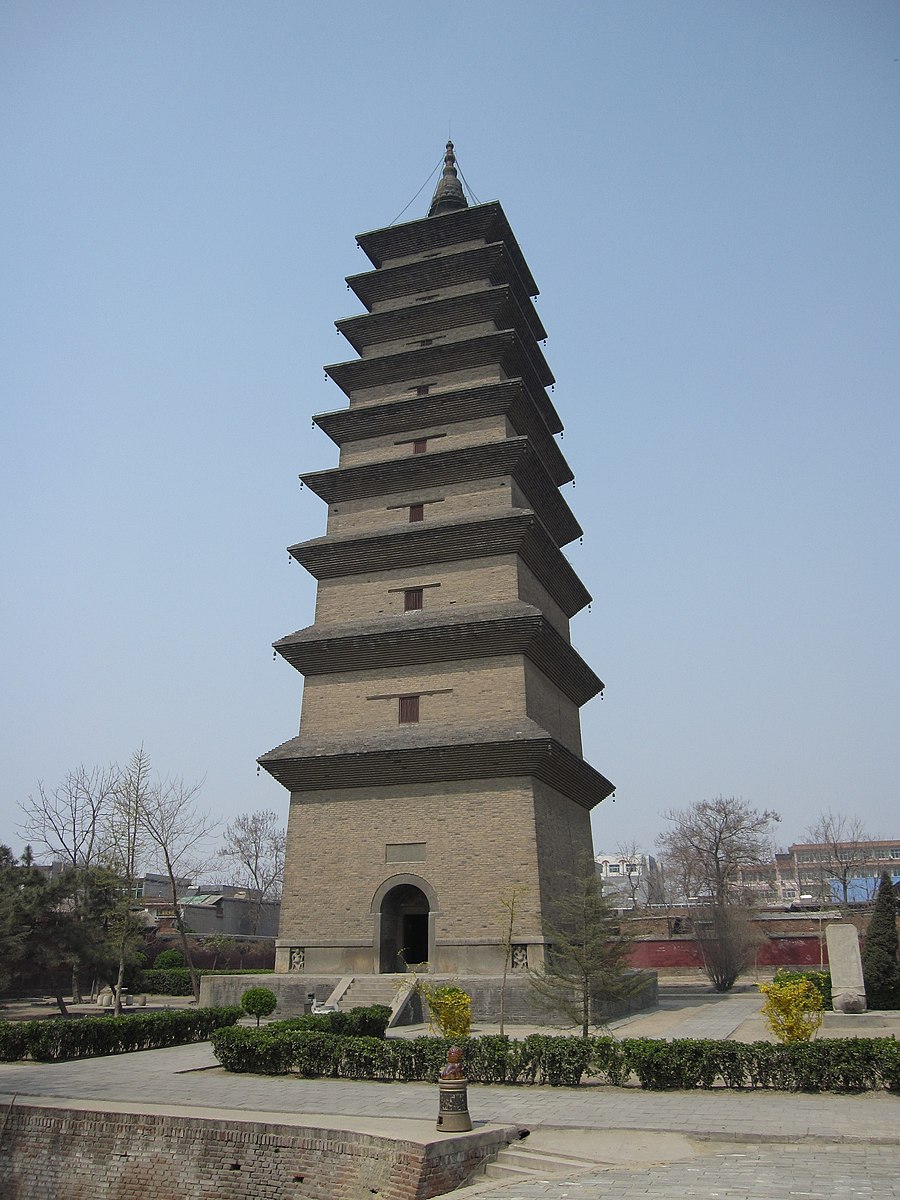
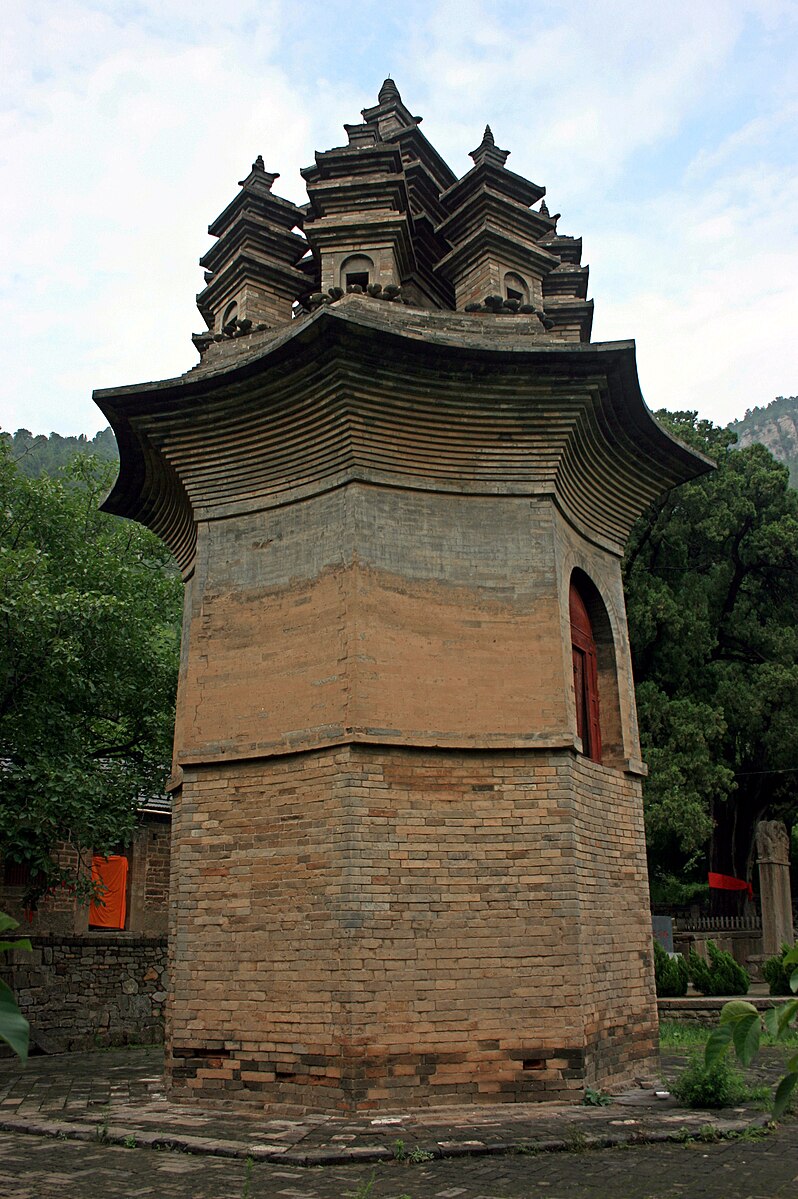
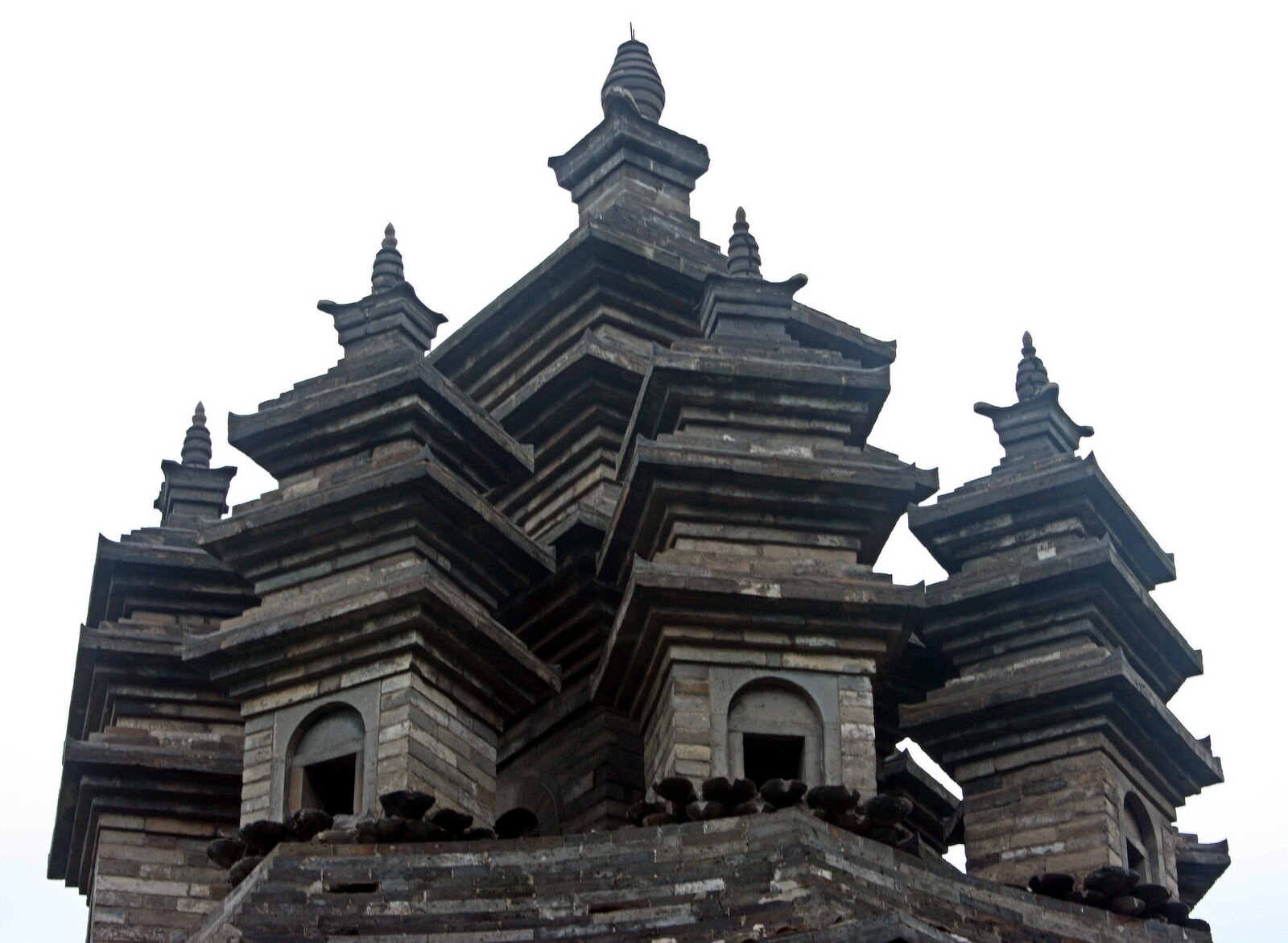
Terracotta Sculpture
The lighthearted terracotta figures were some interesting artifacts in tombs during the Tang era. The figures represent different parts of daily life; the higher one's social status, the more figures are found in the tomb. One princess had over 170 small figures in her tomb, with the figurines demonstrating different clothing, occupations, religious beliefs, or home countries. The figures were generally made in molds, and the front and back were frequently cast separately and assembled. Colored pigments were added after the figurine was fired. Unfortunately, the colors did not bind to the ceramic well and often flaked off. The glazing technique used three colors (sancai) with amber, cream, and green as the predominant colors and did not produce proper skin tone colors. The base glaze was transparent and fired at 650 to 1000 degrees centigrade temperatures. Green was made by adding copper oxide to the base glaze, and the amber/yellowish brown was made by adding iron oxide.
Blue was seldom used because the cobalt oxide was very expensive.[6]
People were fond of everything from the foreign or outside countries, all styles of fashion, music and musical instruments, and lifestyles or customs. The different ideas were incorporated into the small figures made for tombs. One figure is a civil official (7.4.16) dressed in clothing typically worn by government officials. He has a robe with typical exaggerated, wide, decorated sleeves, an inner gown with a belt, and a high hat noting his position. He is holding a tablet in his hands, ready for work.
The female figure (7.4.17), dressed in elaborate clothing, was an entertainer and a host for parties and games. People were fascinated by foreign fashion and society, and women's clothing reflected the foreign influence. Her hair is formed into large loops. The dress has exaggerated sleeves like the latest court fashion; the shoulders have wing-like protrusions.
The tomb guard (7.4.18) portrays a fierce person standing by and ready to repeal any invader. The face on the figure was often based on a natural person's image. The guard is standing in contrapposto positions, one foot higher, ready to act. The figure's arm appears to hold a weapon and display his fierceness. The guard's clothing is very elaborate and painted with strong sancai colors.
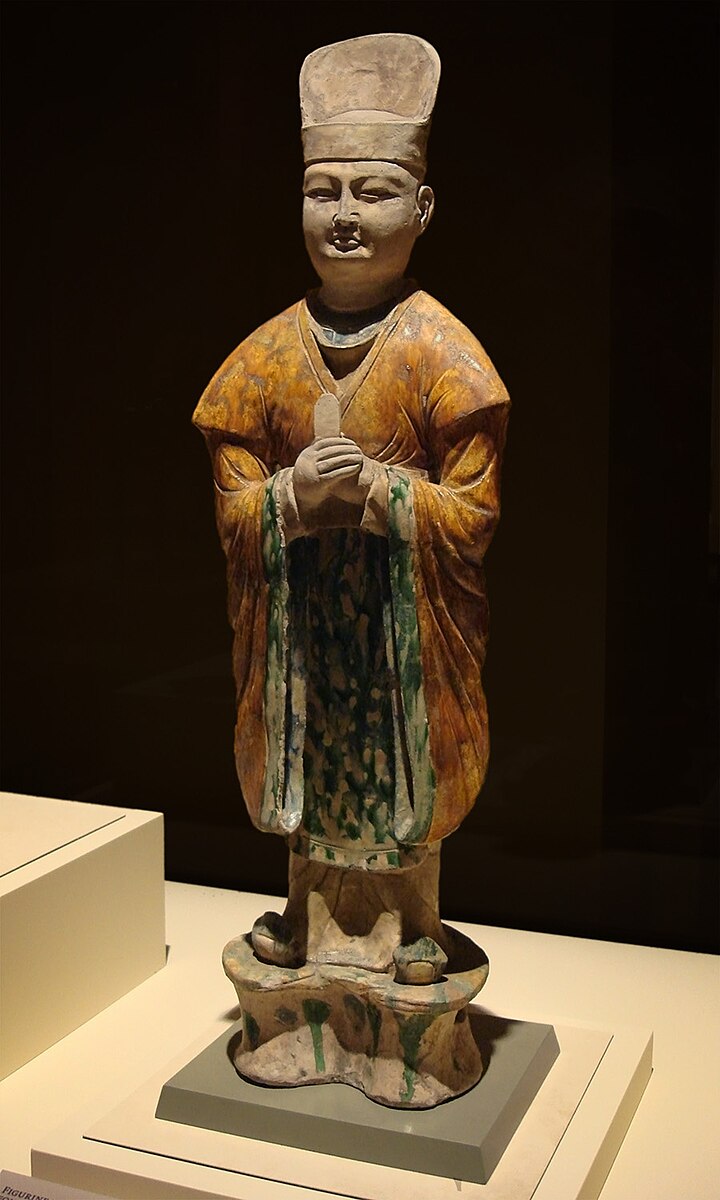


Animals, especially horses and camels, were commonly found in tombs. Some animals were plain; however, the horses and camels were generally decorated with saddles, harnesses, or other accouterments. The camel (7.4.19) has its head raised and mouth open, a typical facial expression found on camel figurines and demonstrating the camel's displeasure. The rider is perched on the camel, resting from the long ride. He is wearing the clothes of a foreigner who traveled with the caravans on the trade routes. The characteristic boots and hat designate a person from Western Asia.
Polo was a game introduced to the Chinese by the Persians. The elite played the game, and women were able to play. The female polo player (7.4.20) rode the horse astride like the male players. She wore similar clothing to males, except her hair was formed into loops. In the figurine, both the horse and rider appear in full motion, the horse's legs full out, and the rider turns to make a play.

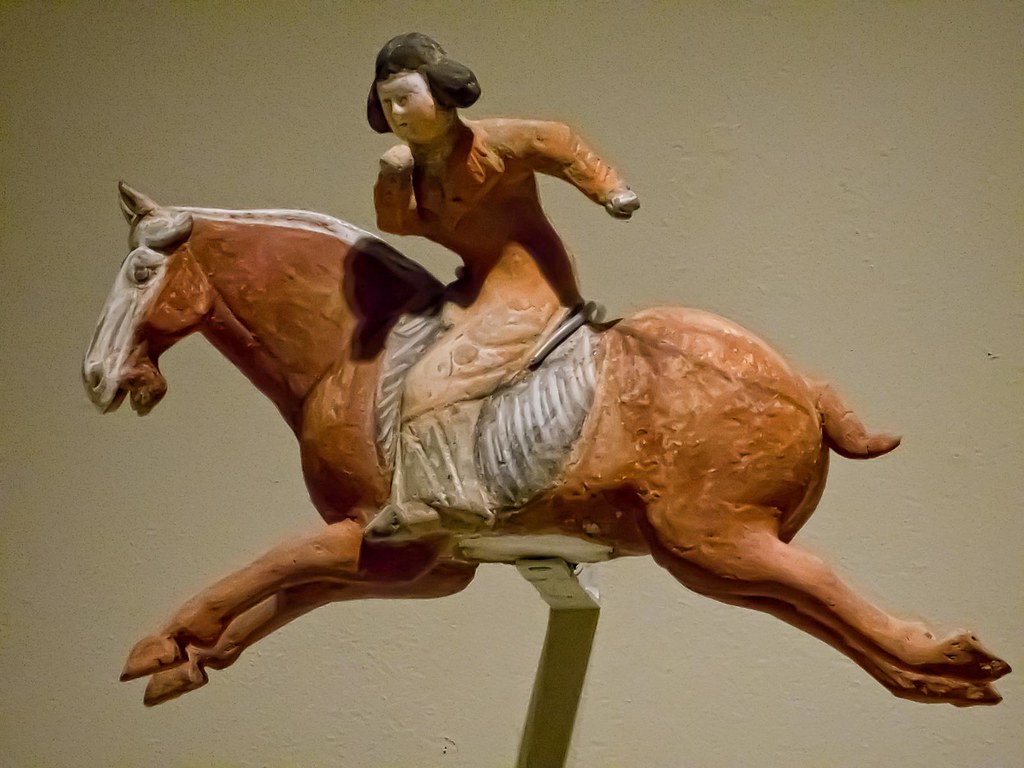
Polychrome figures (sancai), 618–907 C.E. (Tang dynasty), white clay, lead oxide flux and glazes colored with copper, iron, manganese, and cobalt; fired at 800 degrees Celsius (Shanghai Museum) A conversation between Dr. Kristen Loring Brennan and Dr. Beth Harris.
Additional text/introduction.
Painting
During the Tang dynasty, figure painting became a significant art form. For the first time, there were major identifiable artists whose artwork survived and was associated with the artists' names. All types of people, monks, emperors, courtesans, and even Buddha, became the subject matter for artists to paint. Tang dynasty artwork was found in caves, murals, buildings, and more portable scrolls and silk screens. The methods used by the artists and their different styles influenced art in other countries. The painters include:
- Yan Liben (600-673 CE)
- Wu Daozi (680-740 CE)
- Han Gan (706-783 CE)
- Zhou Fang (730-800 CE)
Yan Liben
Yan Liben (600-673) was a painter, architect, and politician. He believed writing poetry was his best talent, and the emperors only considered him a painter. Unfortunately, painters were not held in as high esteem as poets. Many poets and writers of the period believed Yan Liben's paintings were "works among the glories of all times."[7] The Thirteen Emperors Scroll (7.4.21) is Yan Liben's most well-known surviving work. The scroll depicted emperors from previous Chinese history divided into sections, with each emperor performing some action. Yan Liben painted and defined each character with defined and controlled lines. His palette was limited to black and gold for the background and parts of the essential clothing. White and red were used for accents.

Emperor Wu of Jin (7.4.22) was from the 7th century and is depicted in his full court regalia at the court's special occasion. The painting was part of the Thirteen Emperors' Scroll. His black robe had the typical oversized sleeves as part of the court's formal wear, clothing worn only by specific elite people or the emperor. The attendants are clad in gowns worn by court officials, including red robes and towering hats with ear coverings.
Emperor Wen of Chen (7.4.23) was emperor in the 6th century and wore less formal clothing than later emperors. The detailed drawn lines defined the images. All three pictures wear golden-colored robes; only the emperor has added black and red details. Red highlights the throned and the decorations in the women's hair. His headdress is very simple and only covers the top of his head. His clothing and headdress would be more elaborate if he were presiding in an official ceremony. In the part of the painting about Emperor Yang of Sui (7.4.24), he is wearing casual attire, including a black robe. His attendants are wearing their usual court officials' clothing. In this section, Yan Liben used light lines of red for the detail on each of the robes. The solid black robe of the emperor dominates the center of the painting.



Wu Daozi
Wu Daozi (680-740 CE) was known for his paintings of murals in temples, tombs, and other buildings and landscape paintings. Wu Daozi was considered a creative and prolific painter with 300 murals and 100 scrolls historians believe he created. However, very few of his works survived, and most of his images were found by reviewing copies of his work, stone engravings, and writings by historians and poets. Wu's parents died when he was young, and he studied painting from local artists. His skill and talent were noticed, and the emperor hired him as an official court painter.
Most artists of the Tang era created images with thin black lines and applied color later to complete the details. Wu Daozi also used black ink; however, he used brushstrokes for the lines and made images without color, relying on the lines for his painting. The lines were fluid, and he made the folds in the clothing or the draped material and ribbons appear to float in the breeze. He was considered a pioneer in creating realistic methods, using brushwork, and landscape painting. Chu Ching-hsüan stated, "What is incomparable is his brushwork, which is always profusely varied and full of untrammeled energy. In several instances, his wall paintings were carried out in ink alone, no one thereafter venturing to color to them."[8]
Wu Daozi painted the Eighty-Seven Celestials (7.4.25) using his brushwork, which many believe to be the best in traditional Chinese painting. The scroll was commissioned by one of the emperor's generals who wanted to honor his deceased mother. The scroll depicts a procession of eighty-seven figures coming down from the heavens.
"According to legend, Wu finished this masterpiece in a single session. In the painting, he lavished great care on such features as exquisite hairdos and bristling whiskers, graceful dresses and robes, beautiful musical instruments and delicate handicrafts, elegant flowers, and plants. The plump faces of the celestial figures not only typify a trend in Tang painting but also reflected the dynasty's prosperity."[9]

Han Gan
Han Gan (706-783 CE) was from a poor family; however, his painting ability was recognized, and a well-known poet sponsored Han Gan. After he completed his studies, he went to court and became a painter. Han became known for his horses when he had access to the royal stables. The emperor had exotic horses from Central Asia and wanted Han Gan to memorialize these unique animals. Han Gan also painted images based on Buddhist and Daoist themes; however, he became known for his works on the imperial horses. Many believed Han Gan captured the horse's spirit. Although the emperor Xuanzong owned thousands of horses, one of his favorites was the horse in Night Shining White (7.4.26). "With its burning eye, flaring nostrils, and dancing hoofs, the fiery-tempered horse epitomizes Chinese myths about Central Asian 'celestial steeds' that 'sweated blood' and were actually dragons in disguise."[10]
Art historian Wen Fong advised, "Focusing on the horse's head, the viewers find themselves suddenly submerged in the awesome power of the artist's simple, plain brush line, discovering shapes and inflections that flow like phrases of music. New details and images reveal themselves as the 'heavenly' horse (or dragon horse) magically prepares to ascend and fly away. This power of brushwork, which is presentation more than it is representation, is what brings viewers back into the presence of the physical 'brush trace' of its maker."[11]
Early writings stated Han Gan painted about fifty-two horse paintings, most of them lost today. When questioned about his methods of painting the horses, Han Gan replied, "I have my teacher. All the horses in Your Majesty's stables are my teachers."[12]
The horse was considered a basic representation of power for the Chinese emperors, even though it was considered exotic. Agriculture was still the principal activity in China, and giving up land for pasture was unacceptable, so only the wealthy had horses. Those horses falling into the spectacular category had the best trainers. A Man Herding Horses (7.4.27) depicts the trainer on the working white horse while the beautiful black horse, one of the emperor's finer horses, dominates the painting. The white horse seems almost a shadow to the starring black horse.
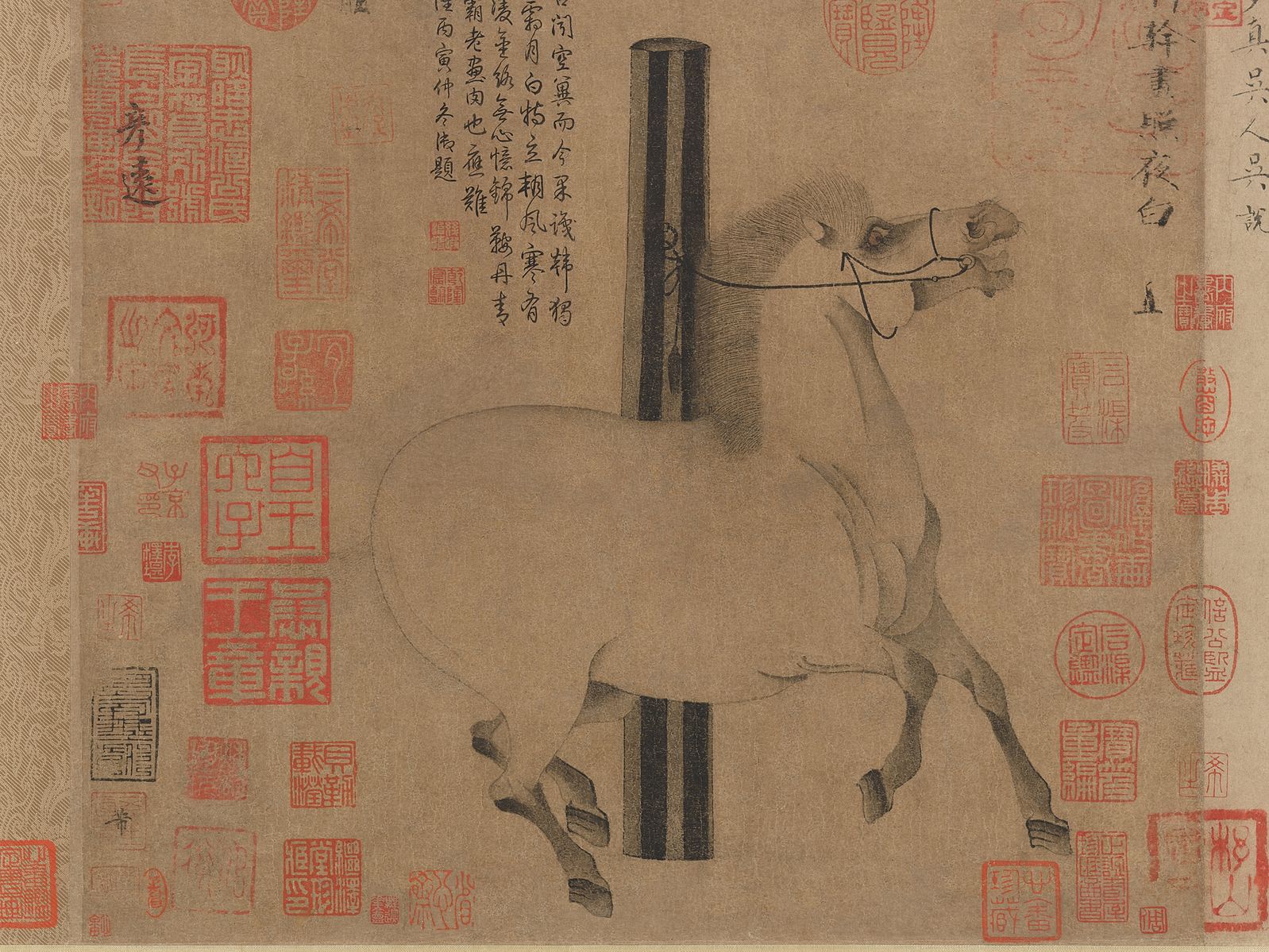
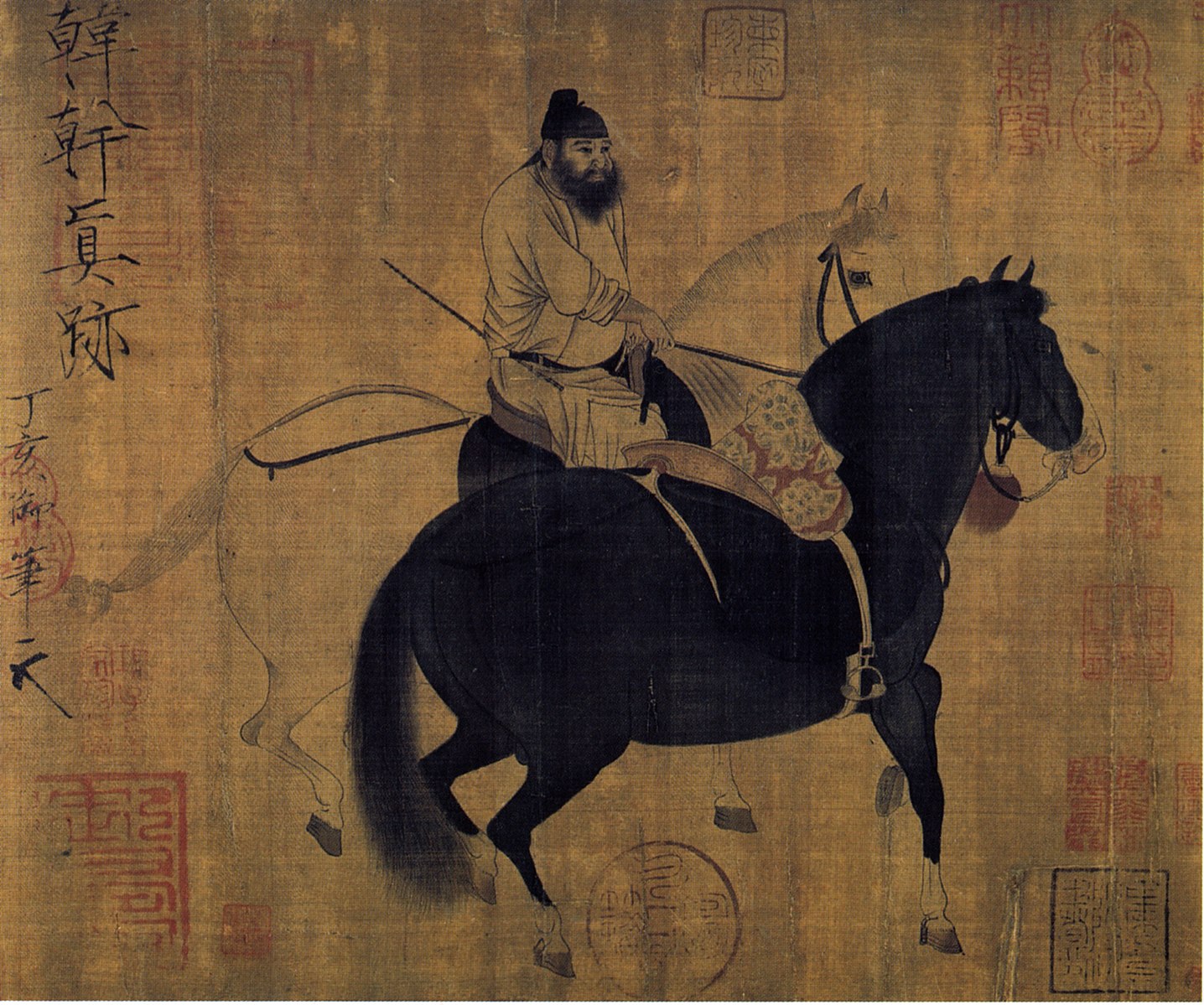
Zhou Fang
Zhou Fang (730-800 CE) was from a noble family, and as a scroll painter, she interpreted the activities from the daily lives of the court ladies. He painted the women as they made tea, played flutes, and performed other activities in the court environment. He also painted for the emperor and some of the court's religious activities. Even his religious goddesses were fashioned in the style of the court ladies. The economy flourished because the court was more stable during the Tang dynasty, and the ideal of painting beautiful women was prevalent. The period also continued to trade and interact with multiple outside cultures, and the clothing restrictions for women were more relaxed and less prescribed. Ladies wore long flowing dresses without other tight restrictive elements. Even the dress's neckline was open, and part of the upper body was revealed.
The painting Ladies Wearing Flowers in Their Hair (7.4.28) depicts five court women and a servant out in the garden amusing themselves. Two of the women are playing with a dog, teasing the dog with some sort of duster on a stick. The women in the middle section show a palace lady holding a red flower and a servant holding a fan. A crane is walking through the scene. The last two women stand near the tree as a dog runs toward them. The women's eyebrows slant upwards, shaped almost like butterfly wings atop their slender eyes. Their long hair is fashioned into buns and highlighted with spots of gold to make ornaments appear. The faces are also covered with a white pigment covering the skin, a fashionable addition. The gowns are loose-fitting, covered with floral or geometric motifs, with scarves to add color and flowing interest.
_Liaoning_Provincial_Museum%252C_Shenyang..jpg?revision=1)
Court Ladies with Servants (7.4.29) depicts the plump bodies and distinctive clothing worn by the aristocratic women and their servants. Zhou Fang's paintings demonstrate the concept of feminine beauty in the period. The clothing was made from woven silks and classified into types defined mainly by their weave. It included "gauzes (sha), crepes (gu), lenos (luo), damasks (qi), single-colored twill (ling), brocades (jin), tapestry (kesi), and multicolored pile cloths. Tang Dynasty names for various silks were based on where they were woven, design pattern, function, or color, and the sampling included here is a broad listing of the principal types."[13]In the court, ladies were concubines, servants, or relations to the emperor and his elite court. Their hair is formed into buns sitting high on their heads and wrapped with a decoration. Each person is performing a different, common daily task. Zhou Fang used red to accent their robes and various elements of the painting.
._(33%252C7x204%252C8)_Beijing_Palace_Museum.jpg?revision=1)
[1] Ebrey, P. B., Walthall, A., Palais, J. B. (2006), East Asia: A Cultural, Social, and Political History, Houghton Mifflin, p 91.
[2] Ebrey, P. B., Walthall, A., Palais, J. B. (2006), East Asia: A Cultural, Social, and Political History, Houghton Mifflin, p 93.
[3] Qianling Mausoleum of the Tang Dynasty
[6] Tomb figures of a man and woman on horseback
[7] Fong, M. H., (1984). Tang Tomb Murals Reviewed in the Light of Tang Texts on Painting, Artibus Asiae 45(1), 35-72.
[8] Sullivan, M. (1980). The Birth of Landscape Painting in China: The Sui and T’ang dynasties, Berkeley: University of California press, (51).
[9] Eighty-Seven Celestials ShanghaiDaily.com, Eighty-Seven Celestials, August 23, 2015.
[11] Hawks, Shelley Drake. (2014). Han Gan. In Kerry Brown (Ed.), Berkshire dictionary of Chinese biography (pp. 489-502). Berkshire Publishing
[12] Hawks, S. (2014). Berkshire Dictionary of Chinese Biography, Berkshire Publishing Group (vol.1, p. 493). Berkshire Publishing


